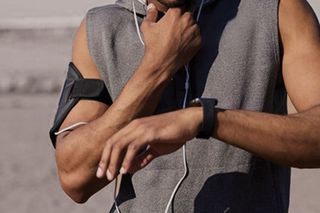
Heart Rate Fitness Trackers May Be Less Reliable for Darker Skin Tones
It’s a case study of the need for greater diversity in health tech.

Most wearable heart rate/fitness trackers use technology that may be less accurate for darker skin tones, according to a report by STAT News. It’s a case study of the need for greater diversity in tech innovation.
The report said the potentially inaccurate technology is used by Fitbit, Garmin and Samsung devices, as well as Apple Watch, though Apple Watch also uses a parallel method of tracking heart rate. The technology in question is photoplethysmography, an optical way of measuring blood flow. Most brands beam a green light at the wrist; an optical sensor measures how much green light is reflected back. When blood volume dips between heartbeats, more light is reflected back; when blood volume peaks during a beat, less light is reflected back because the blood absorbs most of it. The ebb and flow of reflection literally reflect the ebb and flow of the heart’s beat.
However, green light has a shorter wavelength than, say, the infrared light used by hospital-grade heart monitors. A shorter wavelength of light is more easily absorbed by melanin, the pigment that gives skin, hair and eyes their color. The more melanin you have in your skin, the more of the green light your skin absorbs — the less light your skin reflects back to the optical sensor, the more inaccurate the heart rate reading.
Related on The Swaddle:
The Mom Tech Industry Needs a Revolution
While no one has independently studied the effectiveness of green light-based heart rate/fitness trackers on people with darker skin tones, the interplay between green light on dark skin is widely known within industries that use photoplethysmography; a 2017 study found less than half the amount of green light that passes through lighter skin tones makes it through darker tones — which means there’s less light to be reflected back by blood, and likely a less accurate reading. And as STAT News reports, online complaints by darker-skinned consumers abound.
The problem is, green light is the best option available, say tech experts. Infrared light, used by hospital heart rate monitors, and its visible cousin, red light, permeate all skin tones equally well, but too easily and deeply, reflecting off not only blood, but also muscles and other tissue; blue light barely penetrates the skin; violet light is almost completely blocked, depending on skin tone.
But it’s telling that ‘best’ is judged by suitability to fair skin.
“It really is about the existing bias in medicine that we have already,” Kadija Ferryman, a cultural anthropologist who studies the social, cultural, and ethical implications of health information technologies at the Data & Society Research Institute, told STAT News. “No matter what [the] technology is, there is evidence that … inserting another tool, no matter how advanced it is, will likely continue on and continue to uphold the existing biases or exacerbate them.”
Liesl Goecker is The Swaddle's managing editor.
Related


Vaginal Discharge Is a Sign of a Healthy Vagina
